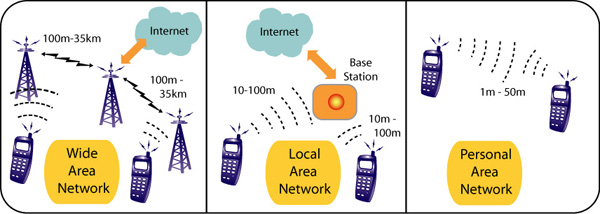1.4.3. Wireless Networks
As already seen in the previous section the wireless communication networks transfer user data and service request messages from the mobile terminal to the service provider and further the requested information back to the user. A possible second task is to use the mobile network to obtain the user position. In general a classification of wireless networks with respect to the covered area is preferred. A useful classification is done into Wireless Wide Area Networks (WWAN) - e.g. GSM and UMTS, Wireless Local Area Networks (WLAN) and Wireless Personal Area Networks (WPAN) - e.g. Bluetooth.
Common to WWAN and WLAN is the principle of a mobile terminal and a base transceiver station. For WWAN a structured network (backbone) of such base stations is necessary to cover a country. Since every base station covers a specific area one does call such network types also cellular networks. Usually the network cells for WWAN overlap only by small portions.
 Different wireless network types. W-WAN: Wireless Wide Area Network, W-LAN:
Wireless Local Area Network and W-PAN: Wireless Personal Area Network
Different wireless network types. W-WAN: Wireless Wide Area Network, W-LAN:
Wireless Local Area Network and W-PAN: Wireless Personal Area NetworkSince WLAN and WPAN cover small areas, (2004) emphasize that these network
types are suited for information services with high granularity like consumer
portal services (e.g. navigation in a shopping mall or museum). In the opposite
WWANs are likely to support large scale services like fleet management, safety
and telematics services, which may cover regions of or a whole country. They
are
therefore useful only for a smaller set of information services.
More
introductory information on wireless networks are given in the unit "Networks & Positioning" of LBS Techniques and can be found in (2004).
